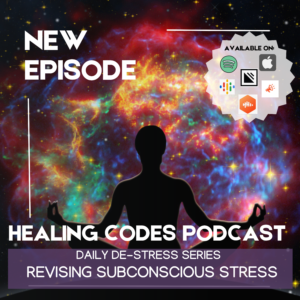
Today’s blog is the third in the Daily De-Stress Series where I’ve been covering the key elements to De-Stressing on all levels of being: Recovery, Resilience and Revision.
Today I’ll be talking about how to identify and revise the deep unconscious patterning underlying stress.
You’ll learn the importance of repatterning childhood conditioning in alleviating the main causes of subconscious stress.
Experience a practical self-help tool called reframing to cultivate your ability to de-stress on a daily basis.
In the previous 2 blogs Daily De-Stress & Radiating Resilience, I covered the importance of a daily self-care practice in allowing yourself to recover from the effects of stress. And how to build personal resilience and transform negative stress into positive stress. I talked about simple ways to incorporate de-stressing techniques into your daily routine through stillness, breath and mindfulness.
In order to fully achieve your full potential to access the states of physiological and energetic recovery needed to be able to strengthen your resilience to stressors, it is necessary to revise old childhood conditioning such as emotional triggers, limiting beliefs and ancestral entanglements.


Depending on what you experienced in your childhood, especially if there was trauma, loss or chronic instability, I recommend working with a skilled therapist to guide you into unpacking your childhood triggers. Even if you didn’t have any major crises in your childhood, I still believe it is a good idea to have a knowledgeable practitioner to help unpack these unconscious patterns because they hide out in our blind spots which often need an objective presence to be brought to the surface.
I developed Consciousness Medicine (CxM) to be able to build a space of support for clients so that their unconscious patterning feels safe enough to agree to find a solution that works for all parts. This is mainly due to the combination of therapeutic modalities that CxM weaves together to treat the Body Matrix.
NLP (Neuro-Linguistic Programming) and Family Constellation ancestral healing work are the two main modalities I use to promote deep and powerful changes in the subconscious mind that allow for new ways of being aligned with health, happiness and harmony to emerge as a sustained reality.
In the last two Daily De-Stress Series blogs we’ve been focused more on the physical and energetic bodies in releasing the negative effects of stress. This is the way the CxM system works best. To support strong, healthy and aligned physical and energetic bodies so that we can address the deeper patterns in the emotional and ancestral bodies with more focus, skill and resourcefulness to identify the source of the issue and bring forward deep and lasting change.
This is the power of whole-person healing, which CxM practice is because it looks at all the levels of being when treating an issue including physical, energetic, emotional, ancestral and spiritual.
To revise the negative effects of stress on your system, the first place to start is to identify your triggers. These are things, situations, people, and places that trigger you into a heightened emotional state. I’m not talking about a healthy normal emotional reaction but one that overwhelms and lingers far longer than is needed to deal with the actual situation.
If you’re on a personal growth path perhaps you will even know what kinds of things trigger you like abandonment, anger, not being heard, betrayal, criticism, or lack of control for example are some of the main ones I see in my clinical practice.
The first step is to identify the situation that triggers you and the main emotion you feel when triggered. This will allow you to identify similarities in your childhood and give you a place to focus on healing the past.
An emotional trigger is a result of an imprint somewhere back on your life’s timeline. Imprints are like storage cells for things that happened in the past, unusually difficult or traumatic, that had an impact in a way that shaped how you relate with yourself and the world.


This is a recipe for emotional overwhelm that will leave you with an emotional hangover. Where your mind will grab hold of that experience and ruminate on it or worry about it happening again. This is the recipe for how a childhood imprint becomes adult triggers that cause stress coming from a subconscious level.
Simply put when we get triggered we regress to a younger, less resourceful version of ourselves. Each time we get triggered, our body physiology will run the biochemical pathways associated with that intense emotion. Our energy body will torque around the pattern of disturbance in our chakra associated with that time in development. Our limiting beliefs and ancestral entanglements will also become activated.
This changes your fundamental frequency of vibration that will have a direct impact on your reality, bringing forward more experiences aligned with those limiting beliefs like not good enough for example. It then becomes a slippery slope since when you drop into a state of suffering your ancestral body becomes flooded with the tidal wave of suffering from our ancestral lineage. Which by the way does not belong to you, but when in a weakened stressed state your system can’t discern this.


Once you are aware of the triggering experiences and the emotions associated we can get started with an exercise to help calm down the imprints and triggers as we revise your stress patterns.
Here are some examples to get you started or that you can use if they resonate:
Being criticised (healthy or not) triggers you into feeling angry.
Feeling unheard triggers a feeling of low self-worth leading to grief or depression.
Being abandoned triggers a feeling of fear or anxiety.
Feeling out of control triggers a feeling of being unsafe which activates fear.
Notice these emotions are the primary ones. Fear, anger, grief. Human feelings are complex so the feeling you identify might be a mixture of primary emotions such as jealousy, resentment, regret, self-criticism, loneliness or rejection.
For starters, this is good since it helps you better identify that complex emotion in your childhood patterning. Eventually, as you work the deeper aspects of these imprints and resulting triggers you will eventually get to the primary emotions. Spoiler alert….they all boil down to some kind of fear. But you don’t have to go for the deepest part of the pain at the start. It’s ok to work towards it over time. This helps reduce the risk of activating old trauma and allows you to build resilience to emotions which will not only help your de-stress process but will also allow you to revise your unconscious patterning over time, which will have a more lasting effect.


When you have your trigger and emotion associated, take a moment to think back in childhood to where you felt this before. Who was it that was involved in having you feel this way? What was going on?
Now without getting too caught up in the emotional part simply identify what age or age range were you. How many other people in your life did you have this experience with? Try to identify the youngest age where you remember feeling this.
Now, let go of that thought journey and come back to your adult self. Wiggle the fingers and toes, get up and move around if you have to if the emotions linger. Remember if you have childhood trauma, you might want to explore this with someone skilled to hold the space.
For the sake of this exercise, simply identify an age or age range that this current-day trigger is associated with.
Now let’s use the power of reframing to help disarm the trigger attached to the bomb of unresourceful emotions. Cognitive reframing is a psychological technique that consists of identifying and then changing the way situations, experiences, events, ideas, and/or emotions are viewed.


For example, looking at something from a broader or bigger-picture perspective is a great way to detach from the emotions of childhood since a child’s ability to take a broader view is not developmentally available. So taking a bigger picture view reframe will bring you back to your adult self and out of your regression to a younger age.
For example, let’s use the child who is criticised by the parent as an example. If we make the picture bigger to include other members of the family is this criticism directed at others too? If so, it’s not about the child themselves but rather just the behaviour of the parent who treats everyone this way.
This realisation will begin to lighten the burden carried by the child and revise the idea that it was something that was wrong with them that made the parent be critical of them. The bigger picture view would be that this is how the parent behaves and really has nothing to do with the person they are criticising.
This leads to another important reframing technique to remove the personal nature of it. Now step into the experience of that parent that is causing them to be critical of the child. What if it comes from a place of trying to protect the child from danger? OR to motivate the child to be the best version of themselves? So the deeper intentions are protection and love. While it didn’t have this desired effect, it allows for a greater compassion for the situation and the people involved to become present. And will begin to dissolve the imprint of resentment, anger or grief when you can see it wasn’t personal and that there was a loving intention behind it.
Reframing is really fun when you get the hang of it. I like to play the game of looking at a situation, usually unpleasant, in as many different ways as I can. Including the most ridiculously positive version. We often don’t have any issues thinking of the worst-case scenario, so working to reframe a situation in your mind will help to open up a bigger-picture view for a more balanced viewpoint.


Notice how this lessens your emotions around it. And allows you to let go of the attachment to that place on your timeline where you used to regress to when triggered.
Moving forward, when you get into a place where a trigger arises notice how you now have more resilience to handle it when you apply the reframe game to let go of the personal nature of it and have greater compassion for what the other person is going through that is making them act this way.
And, here’s the best reframe of them all. When you get triggered you can see that it is about the situation but not about the situation at the same time. It is a reply from childhood, that you’ve projected onto the world and is now appearing to invite you to resolve it once and for all. This reframe helps welcome greater compassion, gratitude and purpose allowing you to let go of the old trigger and empower the new way of being to manifest.
I hope you enjoyed this article, thank you for reading. Next week I’ll bring together all of the Daily DeStress Series elements into a Stress Survival Guide including a guided meditation to integrate stress recovery, building resilience and revising limiting patterns to bring forward a grounded embodied sense of self and a more peaceful mind.
_____________
Find out more about Consciousness Medicine.
Upcoming summer retreats, courses, workshops and 1:1 sessions.
Sign up for my e-newsletter and stay connected on social media with links on the homepage.


